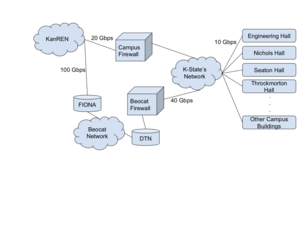Kylehutson (talk | contribs) (Added video link) |
No edit summary |
||
| Line 9: | Line 9: | ||
== Video Demonstration == | == Video Demonstration == | ||
Rather than give dozens of screenshots, here is a video demonstrating how to use Globus to transfer files to and from Beocat | Rather than give dozens of screenshots, here is a video demonstrating how to use Globus to transfer files to and from Beocat | ||
{{# | {{#widget:YouTube|id=D0X7x7B_wQs|width=800|height=600}} | ||
| | |||
}} | |||
Revision as of 12:25, 30 June 2020
Transferring Data using Globus
Globus is a high-speed data transfer service. It is primarily used to transfer data between research institutions, but can also be used to transfer data between Beocat and a laptop or desktop. We suggest using Globus over other file transfer options if you are transferring large data sets. Globus also allows you to share data with those who do not have Beocat accounts.
Beocat has two Globus servers - one on the main campus network, and one directly connected to KanREN (essentially for our purposes, the university's Internet Service Provider). To understand which one you should be using an overview of how Beocat connects to the Internet is useful:
As you can see, if you are ON campus, it's faster to use the "DTN" endpoint, but if you are OFF campus, it is faster to use the "FIONA" endpoint. That being said, due to software differences, those two endpoints behave differently, and either CAN be used either on- or off-campus.
Video Demonstration
Rather than give dozens of screenshots, here is a video demonstrating how to use Globus to transfer files to and from Beocat
